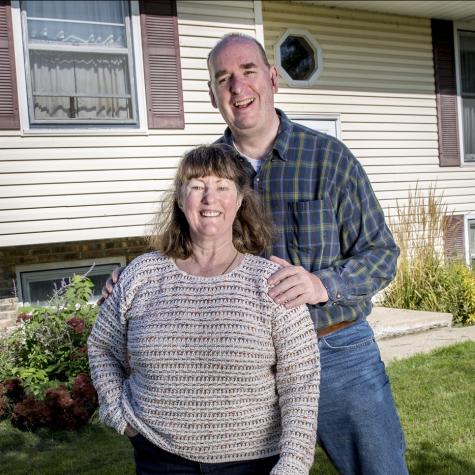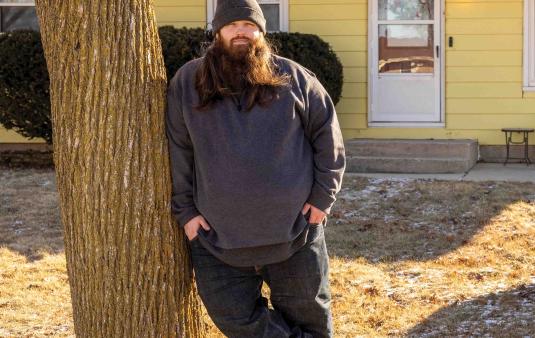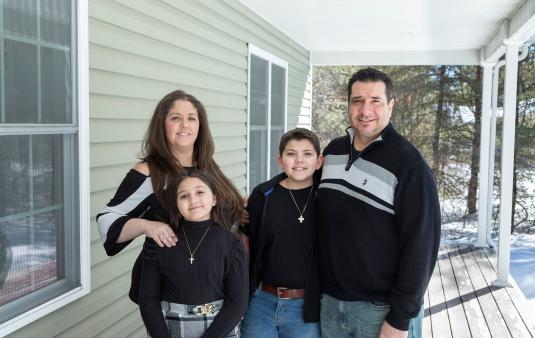How long does it take to foreclose on a home in Connecticut?
Foreclosure is a complicated multistep process that allows mortgage lenders to repossess homes from homeowners who have missed payments on their mortgage loan. Connecticut’s foreclosure process can take three to six months or longer.
What is the best way to avoid foreclosure in Connecticut?
The first step for any homeowner facing foreclosure or eviction should be to contact a HUD-approved housing counselor or an attorney to better understand your options. Housing counselors are typically free and offered by a local nonprofit.
BlueHub SUN may also be an option to prevent foreclosure and eviction. Find out if you qualify.
What are the steps of the foreclosure process in Connecticut?
Understanding the steps involved in the foreclosure process can help homeowners better navigate this difficult situation. Below is a summary of the foreclosure process in Connecticut. It is important to remember, however, that laws can change and how courts and agencies interpret and apply laws can also change. Some rules can even vary within a state.
- Defaulting on the loan:
- Defaulting on a loan means that a payment was missed. Typically, after a grace period of ten to fifteen days from the due date of the first missed mortgage payment, the mortgage lender can charge late fees in addition to the mortgage amount. If the homeowner continues to miss multiple mortgage payments, federal mortgage servicing laws require the lender to take certain actions. The lender must attempt to contact the homeowner by phone within 36 days after each missed payment to discuss foreclosure alternatives, such as a loan modification or short sale. This conversation’s purpose is to explore options that can help the homeowner avoid foreclosure. Additionally, within 45 days after a missed payment, the lender must provide the homeowner with written information about potential foreclosure alternatives. This information is designed to assist the homeowner in understanding and pursuing available options to resolve the delinquency.
- Notice of Default:
- The “Notice of Default” is a legally required document that a lender must send to a homeowner before initiating foreclosure. There is no specific timeline for when the lender must send a notice of default after a homeowner has missed a payment, or defaulted on their loan. The federal law generally allows a 120-day grace period after missing the first mortgage payment before the lender can file for foreclosure. Under Connecticut law, the lender must send a written notice to the homeowner at least 30 days before filing a foreclosure complaint. This notice should include important information such as the amount owed, a breakdown of the debt, the homeowner's rights and any potential options for avoiding foreclosure or resolving the delinquency.
- Filing of Complaint:
- If the homeowner fails to pay back the owed amount (i.e., curing the default), the lender will file a complaint in the Superior Court in the district where the property is located to initiate the foreclosure process. The complaint is the legal document that commences the foreclosure proceedings.
- Issuing the Summons:
- Once the foreclosure complaint has been filed in county court, a summons will be issued to the homeowner. A summons is a legal document issued by the court that notifies the homeowner and must be served to them in person by a “process server” or by certified mail.
- File an Appearance:
- The homeowner must file an Appearance form with the court within 15 days of the Return Date – the deadline set by the court to track the proceedings that can be found in the upper right-hand corner of the Summons. It’s important to note that the homeowner does not have to be physically present in court on the Return Date. If you do not file the Appearance, the lender automatically wins the case, and it will result in foreclosure. The Appearance form can be found here.
- Request for Mediation:
- If the homeowner wishes to participate in mediation, they must file a Foreclosure Mediation Certificate within 15 days after the Return date on the summons. Once a request for mediation is filed, the court will schedule a mediation session within sixty (60) days. The Foreclosure Mediation Certificate can be found here.
- Foreclosure Mediation:
- The mediation session takes place at a designated location, typically a courthouse or other suitable venue. The court will appoint a neutral third party as the mediator to conduct the mediation. Both the homeowner and the lender must attend the session. In the mediation, it is common for the lender to be represented by an attorney. The homeowner can also bring in an attorney, as well as their spouse, or anyone the homeowner believes would be helpful. If an agreement is reached during mediation, it’s put into writing and signed by both parties. This agreement is then submitted to the court by the mediator. If no agreement is reached, the lender can proceed with the foreclosure process.
- Obtaining a judgment:
- In most cases, the judge rules in favor of the lender, resulting in a legal decision in favor of foreclosure. If the foreclosure is approved, the lender next requests either strict foreclosure or a foreclosure by sale. Typically, strict foreclosure is allowed by the court if the amount owed by the homeowner is equal to or exceeds the value of the house. If not, a foreclosure by sale occurs.
- Strict Foreclosure:
- The judge will set a Law Day, which is the last date the homeowner can redeem their house back. The homeowner must pay what they owe plus any additional fees that occur in the foreclosure process. If no payment is made, the property will be automatically transferred to the lender after the Law Day. The Law Day can be as soon as 21 days after the strict foreclosure judgment, but it usually happens 45 to 90 days after the judgment. The homeowner can also file a motion asking for an extension, but the motion needs to be filed before the Law Day.
- Foreclosure Sale:
- After the court enters a Judgment of Foreclosure by Sale, the lender must publish a Notice of Sale on a judicial branch website and in a local newspaper and on two separate dates before the sale. The notice provides details about the date, time and location of the sale and allows interested parties to be aware of the upcoming foreclosure sale.
- The foreclosure sale is typically conducted by the sheriff’s office. The highest bidder at the sale becomes the new owner of the property.
- Following the foreclosure sale, the sale must be presented to the court for confirmation. This step involves the mortgage loan servicer or lender or the party conducting the sale filing a motion with the court, requesting confirmation of the sale.
- The original homeowner has 60 to 90 days between the foreclosure sale judgment (i.e., the judge’s approval of the sale) and the sale date to redeem their home. The homeowner can also redeem the home during the 14 to 30 days after the foreclosure sale up until the court’s confirmation of the sale.
- Deficiency Judgment:
- In Connecticut, if the proceeds of a foreclosure sale do not cover the total amount owed the lender at the time of foreclosure, the lender can hold the borrower liable for the difference, which is called the “deficiency judgment” (see below example). In both strict foreclosure and foreclosure sale cases, the lender cannot pursue a deficiency judgment unless they ask the court to grant one. The lender can only do this by filing a separate lawsuit within 30 days after the foreclosure sale. During this lawsuit, the court determines the amount of the deficiency judgment, which is typically limited to the difference between the “total debt amount” and the market value of the property as determined by the judge. During the lawsuit process, the homeowner can request a reduced deficiency. The homeowner should consult an attorney if they believe the lender is pursuing a deficiency judgment.
- Example: The total amount you owe on your mortgage loan, including outstanding principal, interest, fees and costs, is $300,000. If your home sells for $200,000 at the foreclosure sale, the deficiency is $100,000.
- Eviction:
- After the foreclosure sale is confirmed by the court (see 10(d)), the new owner (the winning bidder at the foreclosure sale) will provide a notice to the former homeowner called the “Notice to Quit.” The Notice to Quit is a legal document that informs the former homeowner that they must vacate the property by a specified date due to reasons stated by the new owner. The new owner must serve the Notice to Quit to the former homeowner through a state marshal either in person or via certified mail.
- Requesting a Writ of Possession:
- If the former homeowner does not leave the property within 3 days of being served the Notice to Quit, the new owner can file a request for a “Writ of Possession” with the court. The Writ of Possession is a court order that authorizes the sheriff's office to physically remove the occupants from the property. The timeline for requesting a Writ of Possession can vary, but it is typically initiated within a few days or weeks after the Notice to Quit expires. Once issued, the Writ of Possession usually requires the former homeowner to vacate the property within 24 hours. While there may be some variation in the timeline, a former homeowner should be prepared to move out of the property on short notice once the new homeowner receives a Writ of Possession.
- Belongings Storage:
- On the specified date and time indicated in the Notice to Quit, the sheriff will arrive accompanied by movers. If the homeowner has not moved their belongings, the movers will proceed to move them out of the house and place their items in storage. It is advisable for homeowners to contact their county authorities (e.g., the Sheriff’s Office) to inquire about the location of their stored possessions. The homeowner typically has a period of 15 days to reclaim their belongings from storage. After this 15-day period, the county authorities may proceed with auctioning off the items. It’s important to note that the authorities may impose a storage fee for the duration of the storage period.
BlueHub SUN can help homeowners in Connecticut
If you qualify, and if you’re willing to do what it takes, you may be able to work with BlueHub SUN as an alternative to foreclosure.
To apply, you have to:
- Be late on your mortgage payments, going through foreclosure or facing eviction due to foreclosure.
- Have a stable income, like a job, Social Security, a pension or disability payments.
- Live in Connecticut, Delaware, Illinois, Maryland, Massachusetts, Michigan, New Jersey, Ohio, Pennsylvania, Rhode Island or Wisconsin.
There is no fee to inquire or apply. You may be eligible even if you have multiple loans, poor credit, or a recent bankruptcy. If you have an upcoming foreclosure sale date, you may still be eligible. Please complete the inquiry form and a BlueHub SUN employee will reach out to you by phone to discuss your situation.
Connecticut Foreclosure Resources
Homeowners seeking assistance with credit counseling, housing counseling, legal counseling, or mental health counseling can reach out to these organizations for support.









